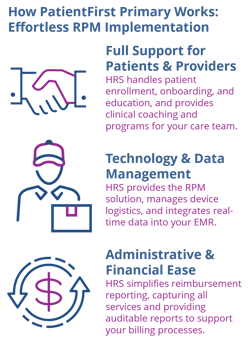
Community health centers, ambulatory clinics, and physician practices stand as the crucial front line of healthcare, delivering comprehensive and coordinated care to countless individuals. However, these vital pillars of our healthcare system are increasingly navigating a complex landscape of pressures: the imperative to elevate patient outcomes, effectively manage chronic conditions, and diligently control costs – often while operating with constrained resources. Juggling these competing demands can inadvertently pull healthcare professionals away from their core mission: dedicated patient care. Let's delve into the significant headwinds these practices face and explore how innovative solutions like Remote Patient Monitoring (RPM) can illuminate a path forward.
The Headwind: Staffing Shortages and Burnout
A pervasive challenge echoing across the healthcare landscape is the critical shortage of medical staff at all levels. Physicians and their dedicated teams are already contending with elevated levels of burnout, making the adoption of new systems or workflows feel like an insurmountable hurdle. This pressure is particularly acute in rural primary care settings, where clinicians often shoulder a broader spectrum of responsibilities due to a sparser physician population compared to urban areas. This expanded scope can significantly amplify existing workload burdens. The administrative burdens associated with managing complex patient populations can be particularly challenging for ambulatory clinics with leaner administrative staff.
The Headwind: Managing Growing and Diverse Patient Populations
The demographic shift towards an aging population in the U.S. is translating to a growing number of individuals managing one or more chronic diseases. Addressing the needs of this increasing volume of patients, often with complex health profiles, is further complicated by limitations in hospital capacity and persistent healthcare team shortages. Moreover, practices serve increasingly diverse patient populations, including those in rural communities where access to care can be geographically challenging, despite similar patterns of outpatient visits for many health indicators. It's also important to recognize that patients in rural settings may disproportionately experience high poverty rates or live with disabilities. Coordinating care with essential ancillary services, such as imaging, can be particularly arduous in rural locations due to limited availability. Ambulatory clinics often serve as crucial access points in both urban and suburban settings, requiring efficient coordination with specialists and hospitals. Compounding these challenges are the social determinants of health (SDoH) – factors like socioeconomic status, education, and access to resources – which can significantly impact a patient's ability to proactively manage their health. Community health centers, including FQHCs and others serving specific populations, often have deep ties within their communities and a nuanced understanding of the unique SDoH challenges their patients face.
The Headwind: Maintaining Cost Controls and Financial Sustainability
Healthcare organizations across the spectrum, including community health centers, ambulatory clinics, and physician practices, are under mounting pressure to curtail preventable healthcare utilization, such as avoidable hospital readmissions and prolonged lengths of stay. This drive is fueled by initiatives like the Hospital Readmission Reduction Program (HRRP) and the broader industry movement towards value-based payment models, which incentivize quality and efficiency over volume. For Federally Qualified Health Centers (FQHCs), which often operate on tight budgets and serve vulnerable populations, controlling costs is particularly critical for their financial viability and ability to reinvest in community health initiatives. Ambulatory clinics, while often more agile, still face significant overhead and are constantly seeking to optimize resource allocation while providing accessible and efficient care. Similarly, physician practices, whether independent or part of larger systems, are actively seeking innovative strategies to cultivate new and sustainable revenue streams to offset rising operational costs and maintain financial stability. Concerns surrounding the potential for substantial upfront infrastructure costs associated with implementing solutions like RPM can create a perceived financial barrier for all these practice types, particularly in the wake of economic fluctuations or shifts in funding models.
Charting a Course: Leveraging Technology and Innovative Care Models
Remote Patient Monitoring (RPM) emerges as a powerful technological ally in navigating these complex challenges. RPM establishes a continuous digital bridge between patients and their healthcare providers, empowering individuals to actively manage their medical conditions from the comfort and convenience of their own homes. This technology equips healthcare providers with the ability to monitor both acute and chronic conditions remotely, potentially decreasing the necessity for in-person visits and freeing up invaluable staff time for focused care. For ambulatory clinics focused on efficiency and patient flow, RPM can minimize the need for frequent in-office visits for routine monitoring, optimizing appointment schedules.
The typical RPM framework involves the collection of patient-reported symptoms and vital sign data through medical-grade devices. This information is then securely transmitted to a central platform that can seamlessly integrate with the practice's Electronic Health Record (EHR). This continuous data stream enables care teams to monitor patients based on their unique needs, receive timely alerts when data points fall outside pre-defined parameters, and utilize this information to inform personalized patient assessments and tailor care plans. Effective RPM programs necessitate dedicated staff, often nurses, to efficiently monitor incoming data and respond promptly to alerts. Importantly, the Centers for Medicare & Medicaid Services (CMS) allows for "incident-to" billing under a physician's general supervision, enabling auxiliary staff to bill for certain services, effectively extending the practice's care capacity.
To ensure equitable access and widespread adoption across diverse patient populations, it's paramount that RPM programs proactively address digital health disparities. This includes selecting simple, user-friendly technologies, leveraging cellular service for patients who lack reliable home internet access, and providing individualized onboarding support and training.
Navigating Reimbursement Landscapes
Addressing financial sustainability concerns, CMS has demonstrated a commitment to supporting remote care by increasing reimbursements for RPM and other chronic care management programs for the past four consecutive years, with indications pointing towards continued growth in this area. RPM services can be billed using specific Current Procedural Terminology (CPT) codes that encompass the initial program setup, device transmission, and ongoing monitoring time. Furthermore, Chronic Care Management (CCM) services can generate additional revenue by providing comprehensive support to patients managing two or more chronic conditions. Diligent documentation of the time dedicated to each service is crucial for accurate billing and the establishment of consistent operational policies.
Showcasing HRS's PatientFirst Primary Model: RPM for Better Care, Better Business
For community health centers (FQHCs and other models), ambulatory clinics, and physician practices seeking a streamlined, care-driven approach to RPM and CCM implementation, Health Recovery Solutions (HRS) offers the PatientFirst Primary model. This comprehensive model is specifically engineered to simplify the adoption and management of RPM and CCM, empowering these practices to enhance patient engagement, unlock new revenue streams, and optimize their operational efficiency.
PatientFirst Primary is fundamentally a care-centric model, strategically focusing on patients who require or could significantly benefit from continuous home monitoring. This includes individuals managing conditions such as:
- Patients utilizing GLP-1 medications (e.g., Ozempic, Wegovy, Mounjaro, Zepbound)
- Post-bariatric surgery care
- Endocrine disorders (depending on the specific condition)
- Cardiology and cardiovascular conditions, including Congestive Heart Failure (CHF) and Hypertension
- Nephrology-related conditions
- Neurological conditions
- Any program where regular monitoring using a scale, blood pressure cuff, or pulse oximeter provides significant clinical value.
By leveraging PatientFirst Primary, practices can achieve improved patient outcomes and expand access to crucial care, particularly for underserved populations. This is particularly relevant for FQHCs and other community-focused centers with a mission to ensure equitable access, as well as for ambulatory clinics serving diverse socioeconomic groups. The early identification of potential issues and timely intervention facilitated by RPM data can play a vital role in preventing complications and disease exacerbations. The model supports enhanced chronic disease management through condition-specific programs developed by clinical experts. It actively contributes to reducing health disparities by employing user-friendly technology specifically designed to support health literacy and equity. The solution can also help address critical SDoH and social work needs through integrated symptom surveys and virtual visits. By fostering effective patient engagement and providing customizable risk alerts, PatientFirst Primary can also significantly contribute to reducing unnecessary hospital readmissions.

PatientFirst Primary is designed as a turnkey solution tailored to the unique needs of physician practices and FQHCs. HRS assumes a significant portion of the operational burden, allowing the practice to maintain a generally hands-off approach. HRS manages patient outreach and enrollment based on eligibility files or EMR referrals, ensuring a seamless onboarding experience for both patients and staff. They also handle all aspects of device logistics, including procurement, delivery, patient onboarding, and ongoing education.
A cornerstone of the PatientFirst Primary model is the clinical monitoring provided through HRS CareConnect. This dedicated service acts as an extension of the practice's care team, diligently monitoring patient-generated data, efficiently responding to alerts, and escalating validated issues as needed, thereby helping the practice meet crucial CPT requirements. HRS also provides clinical coaching and tailored programs relevant to specific patient conditions as an integral part of the service. The platform offers real-time data integration with the practice's existing EMR system, ensuring that clinicians have timely and comprehensive visibility into patient data to support informed clinical decision-making.
HRS understands the imperative for physician groups to identify innovative and sustainable revenue streams. PatientFirst Primary directly addresses this need by enabling practices to tap into the growing RPM and CCM market, leveraging HRS's established infrastructure and comprehensive reimbursement support. A key differentiator is the pay-for-performance-based model, where the practice earns revenue from eligible patients and only remits payment to HRS after the patient is successfully enrolled and eligible for reimbursement. This significantly mitigates financial risk, making it an appealing option for practices that may have budget constraints or prefer a performance-driven contract. HRS provides comprehensive and auditable reimbursement reports, streamlining the often-complex billing process. The estimated net revenue per patient can be approximately $88 for RPM and $160 for CCM, offering a substantial opportunity for financial sustainability.
HRS's PatientConnect RPM solution offers flexibility in device types, providing PC Mobile options with either Bluetooth or Cellular peripherals (scale, blood pressure cuff, pulse oximeter), allowing practices to choose the most appropriate option based on the estimated duration of a patient's enrollment in the program.
For over a decade, HRS has been a leading force in RPM, consistently demonstrating proven results and earning annual recognition from industry experts for outstanding customer value, particularly since the pandemic underscored RPM's significant benefits. Their robust solution seamlessly integrates with all major and most smaller EHR systems. They offer comprehensive support encompassing expert reimbursement guidance, evidence-based clinical protocols, and round-the-clock technical assistance, ensuring a smooth and successful implementation and ongoing utilization of the RPM program.
Conclusion
Community health centers, ambulatory clinics, and physician practices are navigating a challenging healthcare landscape marked by staffing shortages, the complexities of managing growing and diverse patient populations, and the constant pressure to control costs. Remote Patient Monitoring offers a compelling technological solution to effectively navigate these pressures. By embracing RPM, these vital practices can achieve improved patient outcomes, enhance operational efficiency, expand access to care for their communities, and unlock new and sustainable revenue streams. HRS's PatientFirst Primary model, with its unwavering focus on delivering a care-driven, turnkey RPM and CCM solution, its commitment to handling operational complexities, providing robust clinical monitoring, and offering a low-risk, pay-for-performance financial structure, is specifically designed to empower these practices to not only survive but thrive in the evolving healthcare ecosystem, all while continuing to prioritize their patients' well-being.